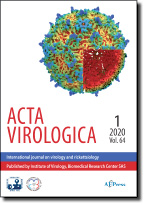Journal info
|
||
Select Journal
Journals
Bratislava Medical Journal Endocrine Regulations General Physiology and Biophysics Neoplasma Acta Virologica Current articles 2023 2022 2021 2020 2019 2018 2017 2016 2015 2014 2013 2012 2011 2010 2009 2008 2007 2006 2005 2004 2003 Studia Psychologica Cardiology Letters Psychológia a patopsych. dieťaťa Kovove Materialy-Metallic Materials Slovenská hudbaWebshop Cart
Your Cart is currently empty.
Info: Your browser does not accept cookies. To put products into your cart and purchase them you need to enable cookies.
Acta Virologica Vol.52, No.1, p.07-15, 2008 |
||
| Title: A POTENTIAL ROLE OF THE HEPARAN SULFATE IN THE HEPATITIS C VIRUS ATTACHMENT | ||
| Author: T. H. HEO | ||
| Abstract: Several putative cell surface receptors have been identified in the Hepatitis C virus (HCV) infection including CD81, low-density lipoprotein (LDL) receptor, scavenger receptor class B type I (SR-BI), and highly sulfated heparan sulfate (HS). In this study, we showed that the binding of soluble heparin to the envelope glycoprotein E2 (E2) of HCV was dependent on the dose and conformation of E2. On the other hand, the binding of E2 to the cell surface after treatment with soluble heparin was not markedly inhibited, what was different from other viruses utilizing cellular HS as the primary receptor. However, the enzymatic removal of HS from the cell surface led to a significant reduction in the binding of E2 to the cells. These facts imply that E2 was bound to cellular HS but might also have another route for cell attachment. Monoclonal antibodies with neutralizing activity against E2 did not completely block the binding of E2 to the cell surface, but their neutralization activity was greatly enhanced in the presence of soluble heparin. Taken together, the cellular HS could act as an alternative receptor for HCV and the interaction of E2 with HS could play a distinct role in escaping of HCV from the humoral immunity. |
||
| Keywords: Hepatitis C virus; E2 glycoprotein; heparan sulfate; receptor; humoral immune response | ||
| Year: 2008, Volume: 52, Issue: 1 | Page From: 7, Page To: 15 | |
|
Price:
21.60 €
|
||
|
|
||

